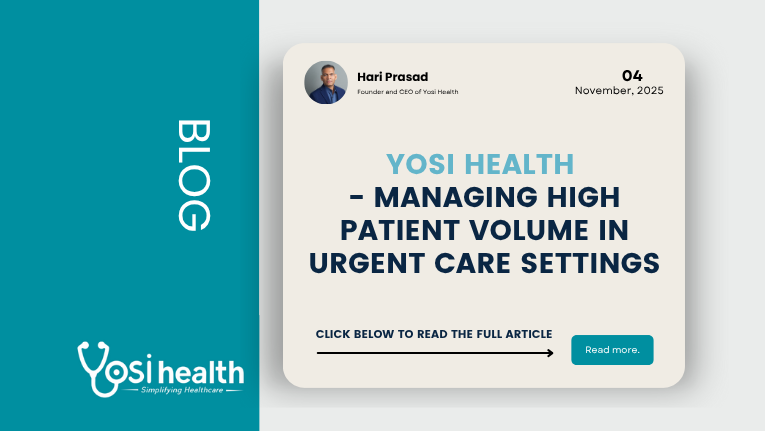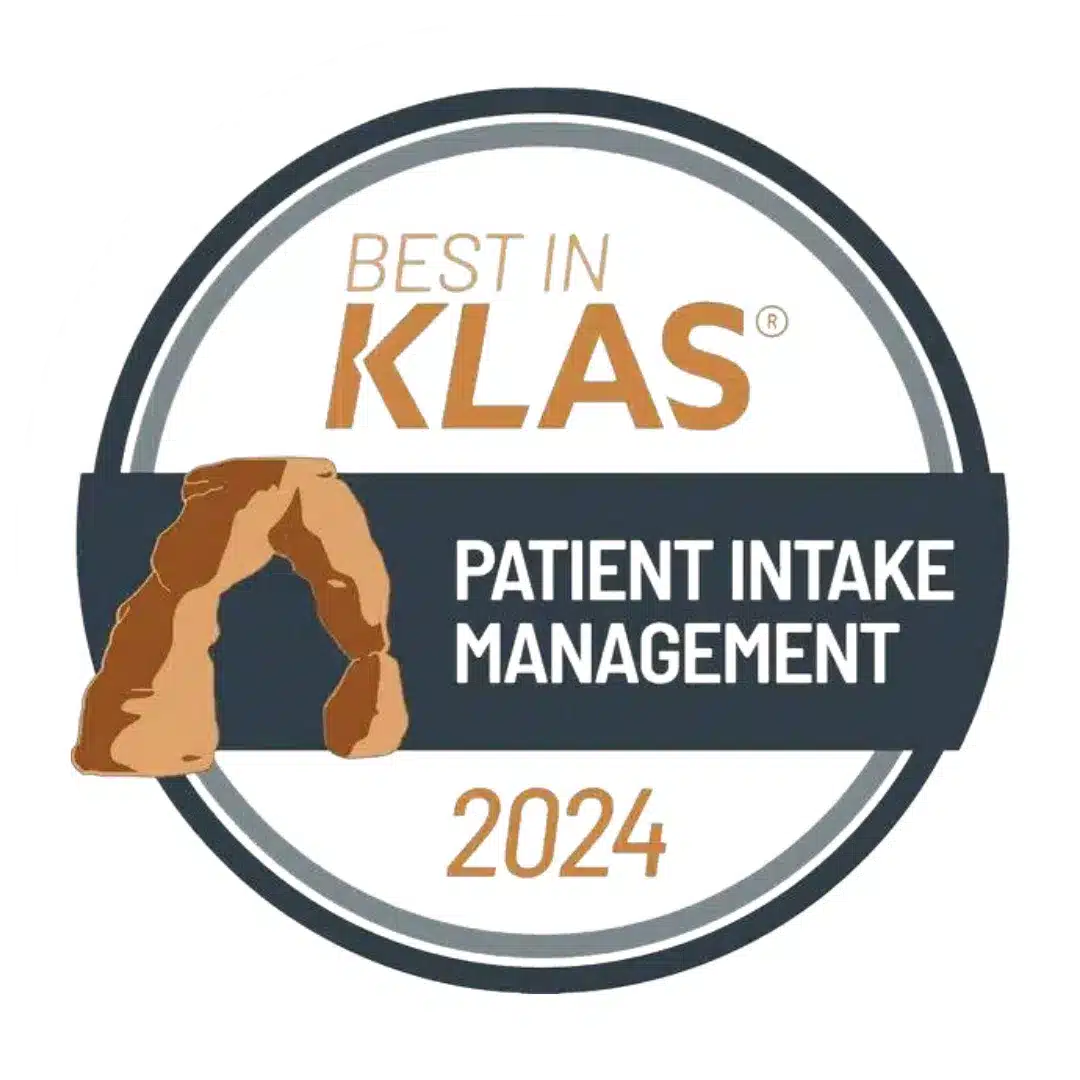
Yosi Health – Managing High Patient Volume in Urgent Care Settings
Discover how urgent care EHR software enhances efficiency and patient satisfaction, streamlining high patient volumes with Yosi Health.
Introduction
Urgent care clinics often walk a fine line between convenience and chaos. When patient volume spikes, even a well-staffed clinic can feel stretched. People walk through the door hoping for quick help, but if the waiting room fills up and the process stalls, satisfaction drops fast. Long lines, delays, and unclear check-in systems can make a simple visit frustrating before it even starts.
Handling high patient traffic isn’t just about speed. It’s about creating a smooth experience while keeping stress low for both staff and visitors. Staff need room to breathe, and patients want to feel like they’re more than the next name on a clipboard. Clinics can offer that balance by improving how things run behind the scenes and giving their teams the right tools to handle busy days. That’s where the right urgent care EHR software becomes part of the conversation.
Common Challenges in Urgent Care Settings
When a clinic is at full capacity, small problems can snowball quickly. A few minutes behind schedule can turn into an hour if the day isn’t managed well from the start. Add in walk-ins, patient questions, and technical hiccups, and it becomes clear that running an urgent care clinic during high volume takes more than just quick reflexes.
Here’s where most clinics run into trouble:
- Long wait times: If patients have to wait too long, frustrations rise and trust disappears fast.
- Overwhelmed staff: Nurses and doctors juggling more tasks than they can handle may miss details or burn out.
- Inconsistent processes: A check-in system that changes day to day or isn’t well explained can confuse both patients and staff.
- Outdated tools: When forms are processed manually or schedules can’t adapt, the system bogs down easily.
- Poor communication: A disconnected team wastes time repeating work or tracking people down.
Take, for example, a Monday morning rush where most patients show up without appointments. If front desk staff can’t sort registration quickly or there’s no way to prioritize more urgent cases, the whole flow gets backed up. The same staff end up fielding complaints, logging information by hand, and trying to direct traffic with no overview of the wait times. And on the back end, providers don’t get the data they need right when they need it.
Tools and procedures built specifically for high patient traffic can change this. By moving to smarter systems and giving everyone clearer processes to follow, clinics have fewer gaps and more room to focus on patient care.
Solutions for Managing High Patient Volume
Solving these problems doesn’t always mean starting from scratch. Often, small changes add up quickly when they’re placed in the right spots. Urgent care clinics can handle high patient flow more smoothly by focusing on key actions that reduce friction and save time.
Here are a few effective ways to keep traffic controlled and care consistent:
- Rethink check-in workflows
Use a check-in system that guides patients step-by-step. Whether it’s a tablet, kiosk, or front desk form, the setup should collect the right info early without slowing things down. Help staff spot what the patient needs quickly so their next step makes sense. - Schedule smarter and flex on the fly
Even in walk-in models, there are ways to adjust staffing based on known trends. If weekends or early mornings are typically busier, plan more coverage during those windows. Adding short breaks between blocks of appointments also gives staff time to catch up. - Make layouts work for flow
Set up patient areas so people aren’t clustering in one place. Keep intake and exam spaces clearly marked. Back office areas should function with minimal cross-traffic so that teams can move freely without delay. - Standardize staff roles during high flow
Assigned stations or clear roles help staff know where their focus should be when the patient volume increases. If one person handles intake while another monitors progress through the system, it limits overlap and keeps things moving. - Maintain a backup plan
Have a process in place for when your current system can’t keep up, whether it’s manual checklists, extra staff to call in, or a triage method to sort urgent cases quickly.
These tactical moves give urgent care practices more breathing room, even when things get hectic. Bringing them all together through an easy-to-follow system allows staff to stay calm and confident while patients move through more quickly without feeling rushed.
The Role Of Urgent Care EHR Software
It’s a lot easier to manage high foot traffic when you’re not juggling paper forms, handwritten schedules, or endless status updates over the phone. That’s where urgent care EHR software makes a real difference. With the right platform in place, clinics can run more smoothly, even when patient volume spikes.
A digital EHR system can take care of many small but time-consuming steps that add up fast during peak hours. Think about what slows down front desk staff the most—chasing down missing insurance details, trying to read messy handwriting, updating the same info in three different places. Those minutes add up and lead to more delays.
What often helps is an EHR tool built specifically for the way urgent care clinics operate. These platforms offer features like:
- Automated scheduling that adapts to same-day visits, referrals, and cancellations without confusion
- Live patient tracking so staff can see where each person is in the process, whether they’re waiting to be seen or finishing up with treatment
- Smart intake forms that can flag missing fields, upload photos of ID and insurance cards, and sync data straight to the chart
- Real-time updates between the front desk and medical staff so everyone’s working from the same timeline
- Organized dashboards that show clinic status, open appointments, and patient flow on screen
Imagine a clinic using one of these platforms on a backed-up Tuesday afternoon. A patient walks in, checks in through a tablet, answers questions digitally, and gets added to the schedule without even needing to speak. From there, their info seamlessly moves to the clinical team, cutting out delays. The result? Staff aren’t scrambling, and patients move faster through the phases of care.
When set up right, EHR software leads to fewer paperwork pile-ups, faster handoffs, and less pressure all around.
Training And Staff Engagement
Technology can’t run a clinic on its own. Even the most advanced tools don’t help much unless the team feels confident using them and wants to use them. That’s where training and staff engagement come into play. If you want to keep patient care moving smoothly, your front-line team needs to be on board and ready for anything.
A simple training plan that shows employees how to use new tools without overloading them can go a long way. Make sure learning is hands-on and gives them time to ask questions, run through real-life examples, and test the workflows before they go live. Don’t overload them with technical details. Focus on the parts of the job that directly affect what they do each day.
Ongoing check-ins matter too. When staff see leadership listening to their input, fixing issues quickly, and adapting tools based on what they need, they’re more likely to stay engaged and stick around. That helps with consistency, especially on those high-volume days when new hires might still be learning the ropes.
Ways to keep staff motivated include:
- Offering regular refresher sessions to keep everyone on the same page
- Setting up feedback channels where teams can highlight what’s working or what isn’t
- Giving recognition for problem-solving, flexibility, or improving patient flow
- Checking on burnout signs and workload before it turns into turnover
Working in urgent care means each day looks a little different. But when staff feel trained, supported, and heard, they show up better on the hard days and deliver the kind of care people remember for the right reasons.
Enhancing Patient Communication And Experience
For most visitors, the time between walking into the clinic and walking back out is what shapes their opinion of the care they received. Even if treatment is fast and on point, sitting in silence with no updates will frustrate most people. That’s why communication is so important in fast-paced care settings.
Patients like when they know what’s going on. Whether it’s how long the wait will be, what they need before being seen, or what their next steps are, simple touchpoints go a long way. Clinics can meet that need in different ways:
- Posting live wait times in the lobby or on-screen
- Sending quick text updates or alerts through a portal
- Providing a printed summary after the visit with care steps and follow-up notes
- Offering clear directions verbally, so patients don’t feel unsure about where to go next
Some clinics also benefit from using healthcare-specific messaging systems that let staff reach out without playing phone tag. Sending appointment confirmations, reminders, or billing messages in advance helps cut down on confusion and missed connections.
On top of that, empathetic communication makes a difference. Taking thirty seconds to explain a delay, answer a basic question kindly, or ask if someone needs help can shift the whole tone of a visit. People remember the human side of urgent care just as much as the clinical one.
Building better experiences doesn’t mean overpromising or rushing patients out the door. It’s about keeping folks informed, showing you respect their time, and treating every person like they matter.
When Clinics Run Smooth, Everyone Wins
Managing high patient volume is a challenge, but clinics don’t have to choose between speed and care. With hands-on planning, flexible processes, and the right digital tools in place, teams can stay ready for whatever the day throws at them.
The key is to think forward. Clunky systems, disorganized workflows, and unclear expectations cause delays and add stress. But when each piece of the experience is designed to support both patients and staff, everything feels more manageable.
When urgent care settings run smoother, providers can do more of what matters—helping people feel better, faster. And patients walk away feeling like they were seen and cared for, not just processed and pushed through. That’s what turns a rushed visit into a trusted one.
See how Yosi Health’s urgent care EHR software can help your clinic stay organized, manage patient volume efficiently, and create a better experience for everyone who walks through the door. With tools designed specifically for the demands of urgent care, you’ll streamline operations and support your team with less stress and more clarity.


